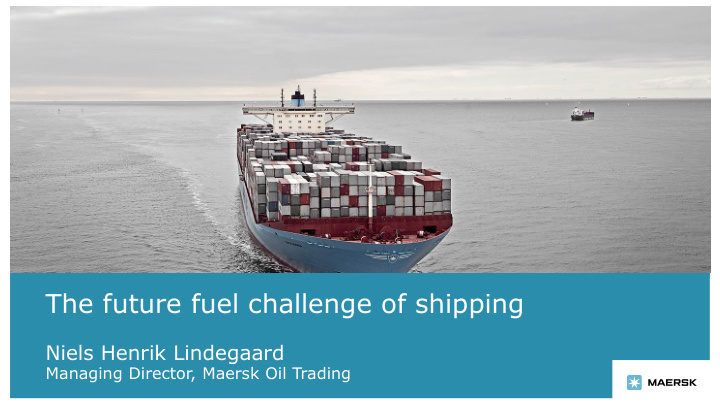



The future fuel challenge of shipping Niels Henrik Lindegaard Managing Director, Maersk Oil Trading
Ownership structure A. P. Møller Holding A/S The Moller Family Foundation Den A. P. Møllerske Støttefond Other shareholders 41.51% (51.23%) 8.54% (12.94%) 3.00% (5.91%) 47% A.P. Møller – Mærsk A/S Transport & Logistics division Energy division Maersk Line A/S APM Terminals B.V. Maersk Container Industry A/S Mærsk Olie & Gas Maersk Drilling Maersk Maersk Tankers Maersk Training A/S A/S Supply Service A/S A/S Svitzer A/S Damco A/S International B.V. Share capital in % Percentages in () = Votes
A.P. Moller – Maersk at a glance
Transport & Logistics division MAERSK LINE APM TERMINALS SVITZER DAMCO MAERSK CONTAINER INDUSTRY Revenue Revenue Revenue Revenue Revenue USD 20,715m USD 4,176m USD 642m USD 2,507m USD 564 Underlying profit Underlying profit Underlying profit Underlying profit Underlying profit USD -384m USD 433m USD 89m USD 31m USD -53m Employees Employees Employees Employees Employees 31,858 22,615 2,870 11,292 5,381 Numbers are from full year of 2016 *The underlying profit is equal to the result of continuing businesses excluding the net impact from divestments and impairments.
Energy division MAERSK OIL MAERSK DRILLING MAERSK SUPPLY MAERSK TANKERS MAERSK TRAINING SERVICE Revenue Revenue Revenue Revenue Revenue USD 4,808m USD 2,297m USD 386m USD 877m USD 40m Underlying profit Underlying profit Underlying profit Underlying profit Underlying profit USD 497m USD 743m USD -44m USD 58m USD -4m Employees Employees Employees Employees Employees 4,405 3,325 1,726 2,415 256 Numbers are from full year of 2016 *The underlying profit is equal to the result of continuing businesses excluding the net impact from divestments and impairments.
The global sulphur cap entering into force in 2020
The International Transport Forum at the OECD said: “The total increase in container shipping costs due to the 2015 requirements amounts to USD 500 million ” “The 2020 requirements could add annual total cost in the order of USD 5 billion to USD 30 billion for the container shipping industry”
What are the compliance options from a ship owners point of view?
Compliance options LNG OIL LNG propelled Gas oil/ Scrubbers vessels 0.5% fuel Ease of -- +++ -- implementation CAPEX for -- +++ - newbuilds + X - OPEX ? - ++ Fuel price Operational - ++ - feasibility
LNG Option: • Environmental: Clear benefits • Implementation: Best suited for new builds. CAPEX intensive, 2- stroke solution yet to be matured • Infrastructure : Few high capacity supply locations • Regulation: Design requirements, bunkering safety procedures unclear
Scrubber Option: Economics: Business case looks • appealing Implementation: Complex piece of • equipment, considerable space requirement, CAPEX demanding Operational: power intensive, operation • & maintenance, specialized personnel, consumables Infrastructure: How to get rid of • chemical waste from scrubbing process Regulatory : what will happen to open • loop scrubbers?
What next? • Challenge : Very significant fuel cost impact irrespective solution. CAPEX a constraint • Considerable uncertainty: The choice that looks obvious today may not be the one in 2020 • Safe bets: Gas oil/0.5% seems to be the least risky choice at the moment. ML will not go the scrubber way.
Thank you! Niels Henrik Lindegaard Managing Director, Maersk Oil Trading
Recommend
More recommend